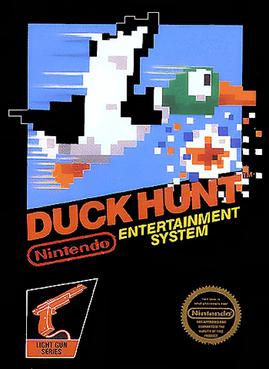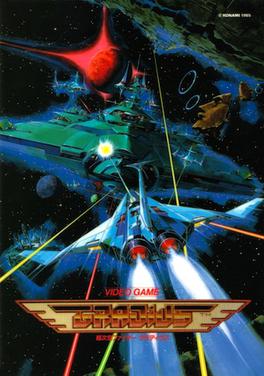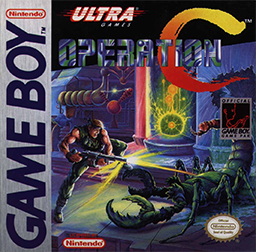
Duck Hunt is a 1984 light gun shooter video game developed and published by Nintendo for the Nintendo Entertainment System (NES) video game console and the Nintendo VS. System arcade hardware. The game was first released in April 1984, in Japan for the Family Computer (Famicom) console and in North America as an arcade game. It became a launch game for the NES in North America in October 1985, and was re-released in Europe two years later.

Gradius is a side-scrolling shooter video game developed and published by Konami. The first game in the Gradius series, it was originally released as a coin-operated arcade game in 1985. The player maneuvers a spacecraft known as the Vic Viper that must defend itself from the various alien enemies. The game uses a power-up system called the "power meter", based upon collecting capsules to purchase additional weapons.

The NES Zapper, also known as the Video Shooting Series light gun in Japan, is an electronic light gun accessory for the Nintendo Entertainment System (NES) and the Japanese Famicom. It was released in Japan for the Famicom on February 18, 1984, and launched alongside the NES in North America in October 1985.

Contra is a run and gun video game developed and published by Konami, originally developed as a coin-operated arcade video game in 1986 and released on February 20, 1987. A home version was released for the Nintendo Entertainment System in 1988, along with ports for various home computer formats, including the MSX2. The arcade and computer versions were localized as Gryzor in Europe, and the NES version as Probotector in PAL regions and France.

Salamander, retitled Life Force in North America and in the Japanese arcade re-release, is a scrolling shooter arcade video game developed and published by Konami. Released in 1986 as a spin-off of Gradius, Salamander introduced a simplified power-up system, two-player cooperative gameplay and both horizontally and vertically scrolling stages. Some of these later became normal for future Gradius games. In Japanese, the title is written using ateji, which are kanji used for spelling foreign words that has been supplanted in everyday use by katakana. Contra, another game by Konami was also given this treatment, with its title written in Japanese as 魂斗羅.

Rush'n Attack, also known as Green Beret in Japan and Europe, is a run-and-gun and hack-and-slash video game developed and released by Konami for arcades in 1985, and later converted to the Nintendo Entertainment System and home computers. Its North American title is a play on the phrase "Russian attack" due to its Cold War setting. It was ported to home systems and became a critical and commercial success for arcades and home computers.

Castlevania III: Dracula's Curse is a 1989 platform game developed and published by Konami for the Nintendo Entertainment System. It was released in Japan in 1989, and in North America in 1990, and in Europe by Palcom in 1992. It was later released on the Virtual Console for the Wii, Nintendo 3DS, and Wii U.

Contra Force is an run and gun game released by Konami for the Nintendo Entertainment System in 1992 in North America. It is a spinoff of the Contra series, being the third game in the series released for the NES following the original Contra and Super Contra. However, the game's plot and setting are unrelated to both previous and succeeding entries, as the villains in the game are human terrorists instead of an alien menace. The game was scheduled to be released in Japan under the title of Arc Hound, with no ties to the Contra series, but was cancelled.
A multitap is a video game console peripheral that increases the number of controller ports available to the player, allowing additional controllers to be plugged in simultaneously in a manner similar to a power strip or a USB hub. A multitap often takes the form of a box with three or more controller ports which is then connected to a controller port on the console itself.

Star Force, also released in arcades outside of Japan as Mega Force, is a vertical-scrolling shooter computer game released in 1984 by Tehkan.

Operation C is a 1991 run and gun video game by Konami released for the Game Boy. It is a sequel to Super Contra, and the first portable installment in the Contra series. Operation C features gameplay and graphics similar to the Nintendo Entertainment System versions of Contra and Super Contra.
The Virtual Console is a defunct line of downloadable video games for Nintendo's Wii and Wii U home video game consoles and the Nintendo 3DS family of systems.

Contra: Hard Corps, released as Contra: The Hard Corps in Japan and Probotector in Europe and Australia, is a run and gun video game released by Konami for the Sega Genesis in 1994, making it the first game in the Contra series released for a Sega platform.

Bio Miracle Bokutte Upa is a Konami video game that was first released for a Japan-exclusive market in 1988 for the Family Computer Disk System. It was later released as a cartridge in 1993 for the Family Computer itself.

Contra is a video game series produced by Konami composed primarily of run and gun-style shooting games. The series debuted in February 1987 with the Japanese coin-operated arcade game of the same name, which has since spawned several sequels produced for various platforms.

Konami's Ping Pong is a sports arcade game created in 1985 by Konami. It is the first video game to accurately reflect the gameplay of table tennis, as opposed to earlier simplifications like Pong. It was ported to the Amstrad CPC, Commodore 64, Famicom Disk System, MSX, and ZX Spectrum.

TwinBee is a vertically scrolling shooter released by Konami as an arcade video game in 1985 in Japan. Along with Sega's Fantasy Zone, released a year later, TwinBee is credited as an early archetype of the "cute 'em up" type in its genre. It was the first game to run on Konami's Bubble System hardware. TwinBee was ported to the Family Computer and MSX in 1986 and has been included in numerous compilations released in later years. The original arcade game was released outside Japan for the first time in the Nintendo DS compilation Konami Classics Series: Arcade Hits. A mobile phone version was released for i-mode Japan phones in 2003 with edited graphics.

Contra 4 is a 2D action game published by Konami Digital Entertainment in the United States and developed by WayForward Technologies. It is the eleventh overall installment of the Contra series, and was released in North America on November 13, 2007 for Nintendo DS. A mobile port was released six days later on November 19, 2007. A rerelease, called Contra 4: Redux, was released for Android in 2011.

Contra ReBirth is a 2D run and gun video game developed by M2 and published by Konami for WiiWare. It is the twelfth original installment in the Contra series. It was released in Japan on May 12, 2009, the PAL region on September 4, 2009, and North America on September 7, 2009.

Contra III: The Alien Wars is a 1992 run and gun video game developed and published by Konami for the Super Nintendo Entertainment System (SNES). It is the third home console entry in the Contra series after Contra (1988) and Super C (1990) for the Nintendo Entertainment System (NES). In PAL regions, it was retitled Super Probotector: Alien Rebels and the player characters were replaced with robots. The player is tasked with fighting off an alien invasion of Earth across six stages. Four stages feature side-scrolling action traditional to the series while two are presented from an overhead perspective. It is the first Contra title to have been directed by Nobuya Nakazato who later directed other games in the series. He designed Contra III to feature more comical elements, a more cinematic soundtrack, and tighter stage design than its predecessors.


















